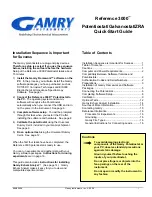
Basic Source-Measure Operation
Perform the following steps to edit the source and compliance values:
1.
Press EDIT to enter the edit mode. The flashing digit indicates which reading (source or
compliance) is presently selected for editing. If you wish to edit the other field, press
EDIT again.
2.
Use the RANGE
▲
and
▼
keys to select a range that will accommodate the value you
want to set. For best accuracy, use the lowest possible source range.
3.
Enter the desired source or compliance value. There are two methods to edit the value:
value adjust and numeric entry.
N
OT
E
To clear the source value to 0V or 0A, press the MENU key while in the edit source
field.
•
Value adjust
— To adjust the value, use the EDIT cursor keys to place the cursor
at the appropriate position, and use the SOURCE
▲
and
▼
keys to increment or
decrement the value.
•
Numeric entry
— When the edit mode is entered, the cursor is located on the most
significant digit of the value. From this position, you can key in the value using the
number keys (0 through 9). After each number is keyed in, the cursor moves one
position to the right. If desired, you can use the EDIT cursor keys to place the cur-
sor on a digit to be changed, and press the appropriate number key. The cursor does
not have to be on the polarity sign of the value to change polarity. If the MENU
key is pressed, the Source Value will be clear to 0V or 0A.
4.
To edit the other field, press EDIT to select it, and repeat steps 1 and 2.
5.
When finished editing the source and compliance values, press ENTER or wait six sec-
onds to exit from the edit mode.
N
OT
E
When a compliance limit value is entered, the SourceMeter automatically goes to the
lowest (most sensitive) compliance range that will accommodate that value.
The lowest compliance levels that can be set are 0.00100pA (1fA) and 000.200mV
(200µV).
Step 3: Select measurement function and range.
Select the desired measurement function by pressing MEAS V (voltage) or MEAS I
(current).
When measuring the source (i.e., Source V Measure V), you cannot select the range using
the measurement RANGE keys. The selected source range determines the measurement range.
When not measuring the source (i.e., Source V Measure I), measurement range selection can
be done manually or automatically. When using manual ranging, use the lowest possible range
for best accuracy. In autorange, the SourceMeter automatically goes to the most sensitive range
to make the measurement.
Summary of Contents for 6430
Page 26: ......
Page 32: ......
Page 78: ...2 14 Connections ...
Page 98: ...3 20 Basic Source Measure Operation ...
Page 138: ...5 30 Source Measure Concepts ...
Page 156: ...6 18 Range Digits Speed and Filters ...
Page 168: ...7 12 Relative and Math ...
Page 176: ...8 8 Data Store ...
Page 202: ...9 26 Sweep Operation ...
Page 248: ...11 22 Limit Testing ...
Page 310: ...16 6 SCPI Signal Oriented Measurement Commands ...
Page 418: ...17 108 SCPI Command Reference ...
Page 450: ...18 32 Performance Verification ...
Page 477: ...A Specifications ...
Page 489: ...B StatusandErrorMessages ...
Page 498: ...B 10 Status and Error Messages ...
Page 499: ...C DataFlow ...
Page 503: ...D IEEE 488BusOverview ...
Page 518: ...D 16 IEEE 488 Bus Overview ...
Page 519: ...E IEEE 488andSCPI ConformanceInformation ...
Page 523: ...F MeasurementConsiderations ...
Page 539: ...G GPIB488 1Protocol ...
Page 557: ......
















































